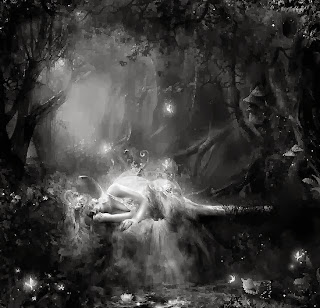Etymology
Middle English from Old English ælf (incubus, elf). Originated from Indo-European root *albho- (brilliant, shining white) via Teutonic languages.Pronunciation
ĕlf, /ɛlf/, /EIf/
1. A mythical, supernatural being resembling but seen as distinct from humans.
2. A luminous spirit presiding over nature and fertility and dwelling in the world of Álfheim (Elfland). Compare angel, nymph, fairy.
3. Any of the magical, humanoid, typically forest-guarding races bearing some similarities to the Norse álfar
Benevolent?
....or malevolent?
"Elves, fairies, and leprechauns are all closely related in folklore, though elves specifically seem to have sprung from early Norse mythology. By the 1500s, people began incorporating elf folklore into stories and legends about fairies, and by 1800, fairies and elves were widely considered to be simply different names for the same magical creatures."
"Like fairies, elves were said to be magical, diminutive shape-shifters. (Shakespeare's elves were tiny, winged creatures that lived in, and playfully flitted around, flowers.)"
"English male elves were described as looking like little old men, though elf maidens were invariably young and beautiful. Like men of the time, elves lived in kingdoms found in forests, meadows, or hollowed-out tree trunks."
"As with fairies, elves eventually developed a reputation for pranks and mischief, and strange daily occurrences were often attributed to them. For example, when the hair on a person or horse became tangled and knotted, such "elf locks" were blamed on elves, and a baby born with a birthmark or deformity was called "elf marked."
"Our forefathers trifled with elves at their peril. According to folklorist Carol Rose in her encyclopedia "Spirits, Fairies, Leprechauns, and Goblins," though elves were sometimes friendly toward humans, they were also known to take "terrible revenge on any human who offends them. They may steal babies, cattle, milk, and bread or enchant and hold young men in their spell for years at a time. An example of this is the well-known story of Rip Van Winkle."
"Another type of elf emerged, one with a somewhat different nature and form than the mischievous and diminutive sprites of yore. Some elves, such as those depicted in J.R.R. Tolkien's "Lord of the Rings" trilogy, are slender, human-sized, and beautiful, with fine — almost angelic — features."
"Tolkien's characters were drawn largely from his research into Scandinavian folklore, and therefore it's not surprising that his elves might be tall and blond. Though not immortal, these elves were said to live hundreds of years. They have also become a staple of modern fantasy fiction."
Their name even gives a clue to their evil nature: it comes from an ancient Germanic term for a nightmare.
Read more at http://www.omg-facts.com/History/In-The-Original-Legends-Elves-Were-Evil/56026#oYYreZ2hTysvTwqd.99
Sources: livescience / yahoo voices
Read more at http://www.omg-facts.com/History/In-The-Original-Legends-Elves-Were-Evil/56026#oYYreZ2hTysvTwqd.99



.JPG)


















No comments:
Post a Comment